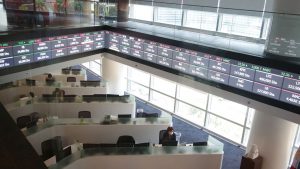By Luisa Maria Jacinta C. Jocson, Reporter
THE BANGKO SENTRAL ng Pilipinas (BSP) is expected to stand pat for a sixth straight meeting this week amid the peso’s weakness and risks to inflation.
A BusinessWorld poll conducted last week showed that all 15 analysts surveyed expect the Monetary Board to maintain its target reverse repurchase rate at a 17-year high of 6.5% at its policy meeting on Thursday.
The BSP has raised borrowing costs by a cumulative 450 basis points (bps) from May 2022 to October 2023.
“We don’t expect the BSP to change policy settings on June 27, but their post-meeting statement may continue to be less hawkish than their rhetoric early this year,” Bank of the Philippine Islands Lead Economist Emilio S. Neri, Jr. said in a Viber message.
“The BSP can afford a more dovish slant on Thursday following downside surprises on headline inflation prints for April and May,” he added.
Headline inflation accelerated to 3.9% in May from 3.8% in April, marking the sixth straight month that inflation settled within the BSP’s 2-4% target band.
“While the latest inflation print for May accelerated slightly, a reading within BSP’s target range of 2-4% for a sixth straight month will give comfort to the BSP,” Sarah Tan, an economist from Moody’s Analytics, said in an e-mail.
“Still, inflation is uncomfortably high at 3.9% which means that it is not time for the BSP to begin monetary policy easing just yet,” she added.
Pantheon Chief Emerging Asia Economist Miguel Chanco said that the Monetary Board is likely to maintain its policy rate as there is still a “small risk” of inflation breaching the upper end of the BSP’s target.
“To be clear, this breach should be temporary, lasting just one month, at most. By August, this temporary breach should have started to reverse, paying the way for the Board to start a normalization of policy,” he said.
The BSP earlier warned that inflation could temporarily overshoot the 2-4% target until July amid base effects.
Security Bank Corp. Chief Economist Robert Dan J. Roces said that the BSP is likely to keep rates steady, influenced by the “prevailing weakness of the Philippine peso and anticipation of pronounced disinflation not occurring until the end of the third quarter of 2024.”
“We think the inflation pressure and the weak currency will continue to constrain the capability of the BSP to cut the rate,” Sunny Liu, lead economist at Oxford Economics, said in an e-mail.
The peso weakened to a 19-month low on Friday, closing at P58.80 per dollar. The local unit depreciated by two centavos from its P58.78 finish on Thursday.
This was its worst finish since its P58.80 per dollar close on Nov. 3, 2022.
“The peso’s fragility, exacerbated by external economic pressures and capital outflows, makes a compelling case for maintaining higher interest rates to support the currency and mitigate potential inflationary pressures from further depreciation,” Mr. Roces said.
Meanwhile, analysts said that the US Federal Reserve’s latest signals would also impact policy decisions by the BSP.
“Number one driver for the BSP to move, I believe, is still what the US Fed wants to do,” Union Bank of the Philippines, Inc. Chief Economist Ruben Carlo O. Asuncion said in an e-mail.
“We see this around the world among global central banks seemingly hesitant to start cutting rates ahead of the US Fed and I do not expect the BSP to be no different,” he added.
The US central bank earlier this month left its policy rate unchanged at 5.25%-5.5% for a seventh straight meeting.
Fed officials are now pricing in just one rate cut this year, compared with expectations of three cuts previously. They also signaled that policy easing could be pushed back to as late as December.
Ms. Tan said that the delay in the Fed’s first rate cut would add to the case for the BSP to stand pat at its upcoming meeting.
“Furthermore, the Federal Reserve’s recent monetary policy pronouncements could also influence the BSP’s stance, as synchronized actions may be necessary to manage cross-border financial stability and prevent disruptive capital movements,” Mr. Roces said.
“Hence, a pause in rate changes would provide BSP with an opportunity to assess the impacts of global monetary shifts while addressing domestic economic vulnerabilities linked to currency performance and delayed disinflation,” he added.
Rizal Commercial Banking Corp. Chief Economist Michael L. Ricafort said that if there are signals of a Fed cut by September, the BSP can start cutting rates in August as there are no other rate-setting meetings in the third quarter.
“We assume that the Fed will ease by 25 bps each in September and December. We also believe that the BSP should not cut rates ahead of the Fed or else risk further exchange rate weakness,” Philippine National Bank economist Alvin Joseph A. Arogo said in an e-mail.
“We expect BSP to wait until headline inflation stays well within the 2-4% target range for a few months before starting cutting,” Zamros Bin Dzulkafli, economist at Maybank Investment Banking Group, said in an e-mail.
BSP Governor Eli M. Remolona, Jr. earlier said that the central bank can begin cutting rates as early as August.
“Lower power prices and slower annual increases in rice prices for June may actually lead the BSP to increasingly hint on an August rate cut. If the July headline inflation print falls below 4%, BSP may gain enough confidence to hint on another cut in October,” Mr. Neri said.
Mr. Arogo said that the recent tariff reduction would also help inflation settle within the target.
President Ferdinand R. Marcos, Jr. last week issued Executive Order No. 26 which updates the tariff rates on various commodities, including rice. The tariff on rice imports was slashed to 15% from 35% until 2028, in a bid to tame rice prices.
“Any local policy rate cut would also be a function of the inflation (likely to be within the BSP inflation target as made more possible with the reduction on rice import tariffs) and also a function of the behavior of the US dollar/peso exchange rate that has an effect on import prices and overall inflation,” Mr. Ricafort added.
On the other hand, Mr. Neri said that the BSP may be unable to cut if second-quarter gross domestic product (GDP) growth surprises on the upside; the Fed continues to delay its policy easing; and if the peso further sinks to the P60-per-dollar level.






